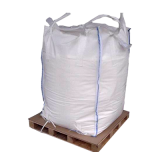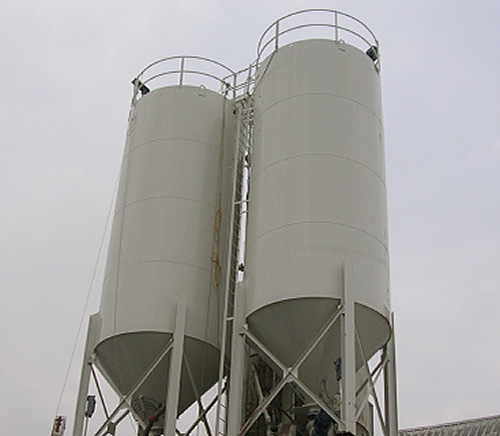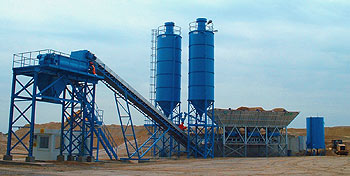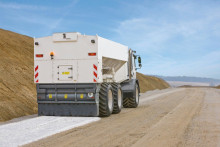Industry Overview
Cement Kiln Dust (“CKD” for the short acronym name) is a by-product that is produced when manufacturing Cement. CKD is the fine-grained, solid, highly alkaline waste removed from cement kiln exhaust gas by air pollution control devices. Because much of the CKD is actually unreacted raw materials, large amounts of it can and are, recycled back into the production process. Some CKD is reused directly, while some requires treatment prior to reuse. Product uses are defined according to the type of Heating Resources used in the process of producing Portland Cement (“Cement”) as this directly affects the outcome of the CKD produced and the uses of the CKD can then be determined. This is the most important factor that most overlook when getting ready to identify the specification of a product for a specific project. CKD is categorized by the EPA as a "special waste" and has been exempted from federal hazardous waste regulations under Subtitle C of the Resource Conservation and Recovery Act (RCRA). The EPA is in the process of developing standards for the management of CKD and has published a set of proposed Subtitle D (i.e., non-hazardous, solid waste) regulations to govern CKD management. CKD can be the major go to product for Environmental Remediation, whether it was to close down a Cell (Pulp-n-Paper type of landfill), Lagoon Closures, Manufactured Gas Plant Sites (“MGP”), and all other Companies tied to the Waste and Disposal Business, which not only do remediation, but dredging, and other activities and services.
 Some of these companies also own their own properties, which they will use for the landfills as a way to dispose of the clean-up materials. Not all of the companies have pits to be used for solidification. The ones that do have their own pits are typically set up to receive the product in silos by pneumatic trucks. Most of the job sites will receive the product by EPA approved Tarp Dump Trailers or by Super Sacks on a flatbed trailer. A Super Sack protects the product from the weather elements by utilizing these weatherproofed one (1) ton Super Sacks to store on the job site without needing any covered buildings.
Some of these companies also own their own properties, which they will use for the landfills as a way to dispose of the clean-up materials. Not all of the companies have pits to be used for solidification. The ones that do have their own pits are typically set up to receive the product in silos by pneumatic trucks. Most of the job sites will receive the product by EPA approved Tarp Dump Trailers or by Super Sacks on a flatbed trailer. A Super Sack protects the product from the weather elements by utilizing these weatherproofed one (1) ton Super Sacks to store on the job site without needing any covered buildings.
 The availability of CKD started fading out of the market because the Cement companies could put it back into the process of making additional Cement at a cheaper price but still maintain the high value of Cement in today’s market. In addition, they started using all kinds of different BTU valued additives like anything from pecan shells, peanut hulls, to plastic bottles, hazardous and non hazardous fuels, paper products, and other products. These additive changes have affected the High Performance Liquid Chromatography (HPLC) test run on CKD. Another test is the TCLP test. The Toxicity Characteristic Leaching Procedure (TCLP) is the Standard Guide for Sample Selection of Debris Waste testing. These tests are a metals testing procedure that could cause another environmental problem in itself. The CKD (Stabilicrete) on the property was burned with Natural Resources, defined as Coal and Natural Gas, and has been tested by some of the best engineering firms in the industry, such as Rone Engineering, which handles the approved products for Texas Department of Transportation (TXDOT). Therefore the concerns set out above on the TCLP test is not an issue with Stabilicrete. This product therefore is a great resource for using it on nationwide Department of Transportation projects for stabilization, solidifying environmental sites, such as the lagoons, chemical waste sites and other uses, including uses for capping oil well sites and solidifying the tailings which has to be taken to a landfill. In addition by process, these tailings have to pass a Paint Filter Test. This test means liquid cannot be leaking out of the truck while going down the road. The CKD addresses this concern. The CKD does the best job for the landfills because when this waste gets to the landfill it continues to solidify and become even harder than Cement. This is due to the pozzolans. Pozzolans, unlike Lime Kiln Dust (”LKD”) has a higher CaO content (Calcium Oxide) which generates more heat. Unless it has significant clay content, it is just basically used for a drying agent so the CKD can work in sandy soils or clay soils. It works for anything when you hydrate it with a liquid, whether that is with water or even a chemical called KO-61 for pit solidification.
The availability of CKD started fading out of the market because the Cement companies could put it back into the process of making additional Cement at a cheaper price but still maintain the high value of Cement in today’s market. In addition, they started using all kinds of different BTU valued additives like anything from pecan shells, peanut hulls, to plastic bottles, hazardous and non hazardous fuels, paper products, and other products. These additive changes have affected the High Performance Liquid Chromatography (HPLC) test run on CKD. Another test is the TCLP test. The Toxicity Characteristic Leaching Procedure (TCLP) is the Standard Guide for Sample Selection of Debris Waste testing. These tests are a metals testing procedure that could cause another environmental problem in itself. The CKD (Stabilicrete) on the property was burned with Natural Resources, defined as Coal and Natural Gas, and has been tested by some of the best engineering firms in the industry, such as Rone Engineering, which handles the approved products for Texas Department of Transportation (TXDOT). Therefore the concerns set out above on the TCLP test is not an issue with Stabilicrete. This product therefore is a great resource for using it on nationwide Department of Transportation projects for stabilization, solidifying environmental sites, such as the lagoons, chemical waste sites and other uses, including uses for capping oil well sites and solidifying the tailings which has to be taken to a landfill. In addition by process, these tailings have to pass a Paint Filter Test. This test means liquid cannot be leaking out of the truck while going down the road. The CKD addresses this concern. The CKD does the best job for the landfills because when this waste gets to the landfill it continues to solidify and become even harder than Cement. This is due to the pozzolans. Pozzolans, unlike Lime Kiln Dust (”LKD”) has a higher CaO content (Calcium Oxide) which generates more heat. Unless it has significant clay content, it is just basically used for a drying agent so the CKD can work in sandy soils or clay soils. It works for anything when you hydrate it with a liquid, whether that is with water or even a chemical called KO-61 for pit solidification.
Products that compete against Cement Kiln Dust are Cement, Lime Kiln Dust, and Quick Lime. Looking at the positives and negatives of CKD reveal that the Industry does not want you to know that CKD has a specification for an environmental utilization making it a competitive alternative to traditional products, as well as lot of private label products in the market that go out and buy these materials and repackage them as new products. In reality, it is the same CKD, LKD or Quick Lime with something added in and filed as a trademarked product. Impurities are sometimes due to the burning process that some Cement companies use to heat their Kilns. This causes companies and agencies to perform TCLP tests, which is a metals test due to the Hazardous Waste materials used for heating sources. THIS DOES NOT APPLY ON THIS CKD AND ALSO MAKES STABILICRETE EVEN MORE VALUABLE DUE TO THE FACT THAT IT WAS HEATED WITH A NATURAL RESOURCE. As a result the CKD is a great resource for environmental remediation utilization as it does not add any additional environmental concerns when used for clean up or remediation purposes.
 Competitive quotes of Stabilicrete provides the best alternative to using Cement and is one third (1/3) of the cost compared to Cement. The main variable when using CKD for any kind of clean up in the field that ends up in a landfill is that the engineers know that with having a good CKD which has Cement qualities once dumped in the landfill, can continue to increase in strength and not break down which helps keep it less permeable to water or turning back into slush.
Competitive quotes of Stabilicrete provides the best alternative to using Cement and is one third (1/3) of the cost compared to Cement. The main variable when using CKD for any kind of clean up in the field that ends up in a landfill is that the engineers know that with having a good CKD which has Cement qualities once dumped in the landfill, can continue to increase in strength and not break down which helps keep it less permeable to water or turning back into slush.
The Cement industry would prefer to sell the “higher dollar cost” Cement to get the highest market price and they have to be careful where they sell a non-natural heated resource due to the possible liability exposure. The Cement industry, as well as Lime Quarries would rather sell the high dollar product Quick Lime and keep the possible applications of CKD very close to the vest. They do sell it to a niche market to keep their dumping costs down. They make limited quantities of this material and cannot provide enough material to do a large job. When someone has eight (8) million tons of CKD, it gets the attention of many environmental companies especially for MGP sites which deal with oil and gas cleanup. In Texas, there are limited options where there is this quantity and quality of CKD available with the capacity to handle large jobs of 5,000 to 250,000 tons.
 CKD is a viable product that can be used for road base as well. When CKD is mixed with crushed rock, the final product results can be used for sub grade stabilization underneath the road surface. There are actually two opportunities for CKD in this arena. One is doing the Sub-Grade Base as described previously where CKD is added to the soil which would be done in instead of Cement soil stabilization. For the purpose of soil stabilization, CKD’s may be segregated into two categories, pre-calciner kiln dust and long-wet or long-dry kiln dusts. The second use, which unlike LKD, CKD can be added with rock, old crushed up concrete and soil to make a very satisfactory Aggregate Base to be applied on top of the Sub –Grade Base. One of the issues with a lot of the roads in Texas is that the roads are not set correctly with an appropriate Sub-Grade Base. When a roadway is constructed in this fashion, the Sub-Grade Base used is not hard enough and gives way in places. This has been most evident in the recent heavy rains recorded in Texas. CKD has a competitive advantage over Cement for usage as a Sub-Grade Base. In the road building world it is all about the foundation and CKD is a product that can be substantially used because it can be mixed with many different kinds of materials to create a hard and stable Sub-Grade Base and its cost gives Stabilicrete a competitive advantage over Cement.
CKD is a viable product that can be used for road base as well. When CKD is mixed with crushed rock, the final product results can be used for sub grade stabilization underneath the road surface. There are actually two opportunities for CKD in this arena. One is doing the Sub-Grade Base as described previously where CKD is added to the soil which would be done in instead of Cement soil stabilization. For the purpose of soil stabilization, CKD’s may be segregated into two categories, pre-calciner kiln dust and long-wet or long-dry kiln dusts. The second use, which unlike LKD, CKD can be added with rock, old crushed up concrete and soil to make a very satisfactory Aggregate Base to be applied on top of the Sub –Grade Base. One of the issues with a lot of the roads in Texas is that the roads are not set correctly with an appropriate Sub-Grade Base. When a roadway is constructed in this fashion, the Sub-Grade Base used is not hard enough and gives way in places. This has been most evident in the recent heavy rains recorded in Texas. CKD has a competitive advantage over Cement for usage as a Sub-Grade Base. In the road building world it is all about the foundation and CKD is a product that can be substantially used because it can be mixed with many different kinds of materials to create a hard and stable Sub-Grade Base and its cost gives Stabilicrete a competitive advantage over Cement.
There are several additional beneficial uses of CKD including but not limited to soil and clay; consolidation and waste stabilization and solidification; Cement additive and blending; mine reclamation; agricultural soil amendment; sanitary landfill liner and cover material; wastewater neutralization and stabilization; pavement; and the manufacturing of concrete products.